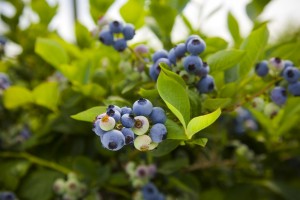Pruning blueberries is an art of balance
Pruning blueberry canes is an art of balance. Growers must tow the line between yield and quality when it comes to pruning, and often it’s a matter of opinion.
“How much is enough?” says Gary Gao, Extension specialist and associate professor of small fruits with The Ohio State University. “Because different growers approach them differently. Some growers aim for a good yield. Other growers aim for the best quality possible.”
It can be hard for growers to decide how much to prune because it takes a conscious decision to eliminate some of the potential fruit. However, as much as growers are risking by pruning, there is also a risk of poor fruit quality if only light pruning is made on a plant.
“If they don’t prune the bushes properly and they leave too many flower buds, when the bushes come out, they can’t support all those flower buds,” says Gao. “The plants will be overloaded with berries and then all of the blueberries will be small and not very sweet.”
Gao also points out that growth will be stunted in the future if a bush is loaded with too much fruit.
“When the bushes produce too much fruit, they will not grow as much (in the future),” says Gao. “If (a grower) didn’t prune them hard enough in 2013, the bushes will not grow as much in 2014 and they will not produce as many flower buds this year, and yield will be reduced next year.”
Age Does Matter
The age of the cane does impact how much pruning should be done to a cane. Gao offers these pruning tips for each growth stage of a blueberry cane:
Young Plantings (less than three years old):
- Remove flower buds to encourage growth
- Remove short, weak stems at the base of the plant
- Remove short, horizontal stems too close to the ground
Fourth Year Through Sixth Year
- Count flower buds on a stem and guesstimate what the yield would be for that bush
- Based on past years’ yields, estimate whether the plant could support a little more yield or whether some buds need to be removed
- Remove short stems with small flower buds
- Remove most horizontally growing canes
- Keep canes that are large in diameter with big flower buds
Mature Plantings
- Maintain proportions of canes of different ages: (two to three each of one-year-old canes, two-year-old canes, three- to five-year-old canes)
- Cut out canes older than six years old to encourage new growth.
With good pruning, Gao says that bushes can last 50 to 75 years. But, growers must keep in mind that canes need to be constantly renewed, keeping a constant ratio of young, thriving, and mature canes.
“(I know of) one planting that was probably 75 years old in northern Indiana; this couple pruned them very hard and very well every year, and from a distance I could not tell,” says Gao. “It looked like a 15- to 20-year-old planting, but it was more like 75.”
Learn By Doing
Gao suggest that pruning is a lot like learning how to swim. He says the best way to learn how to prune is to actually prune.
“You just have to watch how other people prune and then you do it, and you watch more and then you do it again,” says Gao. “It just takes a lot
of practice.”
Gao also suggests that growers seek out their fellow blueberry growers to compare strategies. He says there is more than one way to prune, and it comes down to each individual grower’s preferences.
“Growers have to look at their bottom line; do they want to produce the biggest berries possible, so they can get the highest prize? If you want to have every single berry look perfect, you would prune extremely hard so the berries would be huge and you’ll get the best quality blueberries,” says Gao.
Hold Off On Pruning This Year
Thanks to extreme cold this year, researchers are advising growers to wait to prune. (For more on winter injury, see “Time To Check For Winter Injury”).
March, though, is a good time to see what type of weather injuries the canes may have experienced, and then prune accordingly.
“With the weather being so cold, I would delay pruning until March to see what kind of cold injuries (the plant may have) or what the cold weather has done to the flower buds or to the bushes in general,” says Gao. “If winter injuries are moderate, growers need to make sure that the bushes are not too overloaded with berries by pruning their bushes a little harder.”
Gao says he expects young canes of sensitive varieties to be hit with winter injury, but growers may not see the impact that the weather had on older canes until later in the growing season.
“We’ll probably see the delayed response in May or June, where all of a sudden two or three larger canes may die,” says Gao.
As for what type of crop blueberry growers may expect this year, he says “all bets are off.”
Growing Produce




